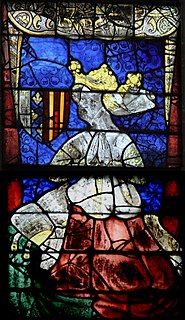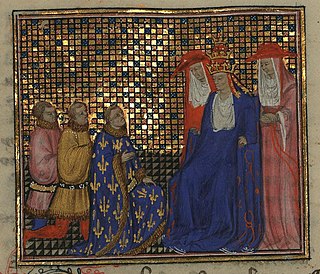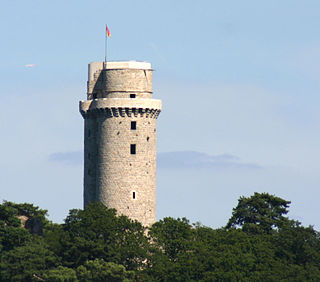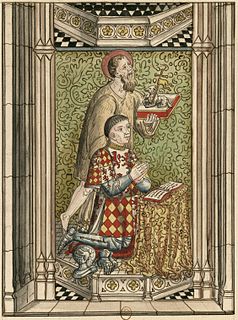
Alphonse or Alfonso was the Count of Poitou from 1225 and Count of Toulouse from 1249. As count of Toulouse, he also governed the Marquisate of Provence.

The House of Bourbon is a European dynasty of French origin, a branch of the Capetian dynasty, the royal House of France. Bourbon kings first ruled France and Navarre in the 16th century. By the 18th century, members of the Spanish Bourbon dynasty held thrones in Spain, Naples, Sicily, and Parma. Spain and Luxembourg have monarchs of the House of Bourbon.

Louis VII, called the Younger or the Young, was King of the Franks from 1137 to 1180. He was the son and successor of King Louis VI and married Duchess Eleanor of Aquitaine, one of the wealthiest and most powerful women in western Europe. The marriage temporarily extended the Capetian lands to the Pyrenees, but was annulled in 1152 after no male heir was produced.

Charles VI, called the Beloved and later the Mad, was King of France from 1380 until his death in 1422. He is known for his mental illness and psychotic episodes which plagued him throughout his life.

René of Anjou was Duke of Anjou and Count of Provence from 1434 to 1480, who also reigned as King of Naples as René I from 1435 to 1442. Having spent his last years in Aix-en-Provence, he is known in France as the Good King René.
Charles the Short or Charles of Durazzo was King of Naples and the titular King of Jerusalem from 1382 to 1386 as Charles II, and King of Hungary from 1385 to 1386 as Charles II. In 1381, Charles created the chivalric Order of the Ship. In 1383, he succeeded to the Principality of Achaea on the death of James of Baux.

John I was a scion of the French royal family who ruled the Burgundian State from 1404 until his death in 1419. He played a key role in French national affairs during the early 15th century, particularly in the struggles to rule the country for the mentally ill King Charles VI, his cousin, and the Hundred Years' War with England. A rash, ruthless and unscrupulous politician, John murdered the King's brother, the Duke of Orléans, in an attempt to gain control of the government, which led to the eruption of the Armagnac–Burgundian Civil War in France and in turn culminated in his own assassination in 1419.

Charles of Blois-Châtillon, nicknamed "the Saint", was the legalist Duke of Brittany from 1341 until his death, via his marriage to Joan, Duchess of Brittany and Countess of Penthièvre, holding the title against the claims of John of Montfort. The cause of his possible canonization was the subject of a good deal of political maneuvering on the part of his cousin, Charles V of France, who endorsed it, and his rival, Montfort, who opposed it. The cause fell dormant after Pope Gregory XI left Avignon in 1376, but was revived in 1894. Charles of Blois was beatified in 1904.

Louis II was Duke of Anjou and Count of Provence from 1384 to 1417; he claimed the Kingdom of Naples, but only ruled parts of the kingdom from 1390 to 1399. His father, Louis I of Anjou—the founder of the House of Valois-Anjou—was a younger son of King John II of France and the adopted son of Queen Joanna I of Naples. When his father died during a military campaign in Naples in 1384, Louis II was still a child. He inherited Anjou from his father, but his mother, Marie of Blois, could not convince his uncles, John, Duke of Berry and Philip II, Duke of Burgundy, to continue her husband's war for Naples. The Provençal nobles and towns refused to acknowledge Louis II as their lawful ruler, but Marie of Blois persuaded them one after another to swear fealty to him between 1385 and 1387.

Yolande of Aragon was Duchess of Anjou and Countess of Provence by marriage, who acted as regent of Provence during the minority of her son. She was a daughter of John I of Aragon and his wife Yolande of Bar. Yolande played a crucial role in the struggles between France and England, influencing events such as the financing of Joan of Arc's army in 1429 that helped tip the balance in favour of the French. She was also known as Yolanda de Aragón and Violant d'Aragó. Tradition holds that she commissioned the famous Rohan Hours.

Charles du Maine (1414–1472) was a French prince of blood and an advisor to Charles VII of France, his brother-in-law, during the Hundred Years' War. He was the third son of Louis II, Duke of Anjou and King of Naples, and Yolande of Aragon.

Pierre de Brézé was a French soldier and courtier in the service of King Charles VII and King Louis XI.

The Château de Ranton is a small fortified castle in the village of Ranton, in the Department of the Vienne just west of Loudun, and south of the Loire. It was one of the front line of fortresses which were built to defend the royal city of Loundun at the beginning of the Hundred Years' War in 1340–1345. It played this military role until 1372. It then became a feudal manor and one of the estates of aristocratic families associated with the Courts of the French Kings and the Dukes of Anjou.

Anjou is a commune in the Isère department, region of Auvergne-Rhône-Alpes, southeastern France.

Louis of Lorraine was a member of the House of Guise, a cadet branch of the House of Lorraine. He married three times and through his daughter, is an ancestor of the present House of Savoy. He was the Grand Squire of France and Governor of Anjou.

Robert of Geneva, elected to the papacy as Clement VII by the cardinals who opposed Urban VI, was the first antipope residing in Avignon, France. His election led to the Western Schism.

The Battle of Montlhéry was fought between Louis XI and the League of the Public Weal on 16 July 1465 in the vicinity of Longpont-sur-Orge. It had no clear winner and therefore did not decide the war.

Pierre de Thury was a French bishop and cardinal of the Avignon Obedience, who served as a royal secretary and Master of Requests, and then as papal Nuncio and Apostolic Legate on several occasions. He participated in two papal elections, those of 1394 and 1409, and was a prominent member of the Council of Pisa in 1409.

Amaury IV of Craon, Lord of Craon, Chantocé, Ingrandes, Briollé, Châteauneuf-sur-Sarthe, Précigné and Sablé, Sainte-Maure, Nouâtre, Pressigny and Marcillac, Châteauneuf-sur-Charente and Jarnac, was a French noble, who was part of the Hundred Year's War.

Louis I de Beauvau, lord of Beauvau and Sermaise in Anjou. He was ambassador to Henry VI of England, retainer of the House of Anjou, and close friend of René of Anjou, he was made a knight of the Ordre du Croissant in 1448. On his final diplomatic mission in 1472 to Rome for René, he died.